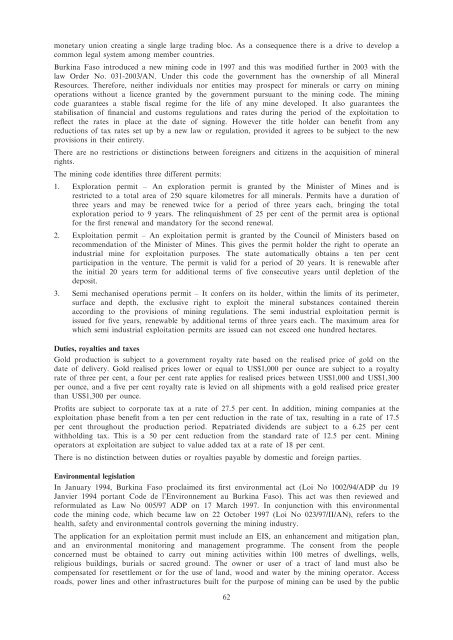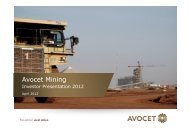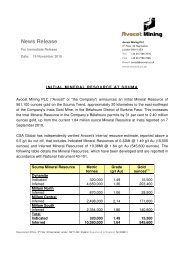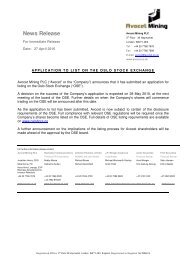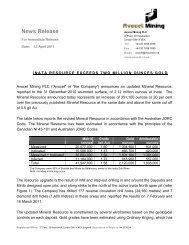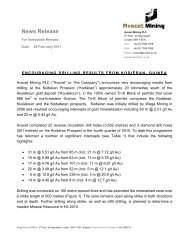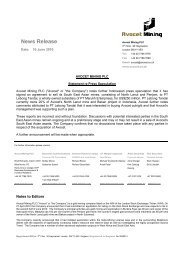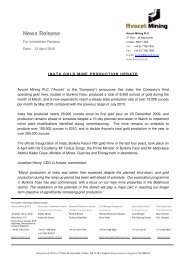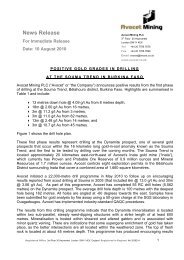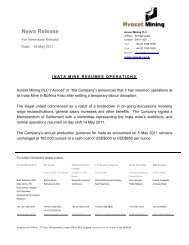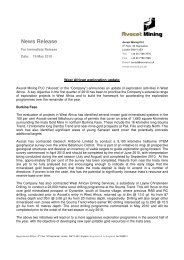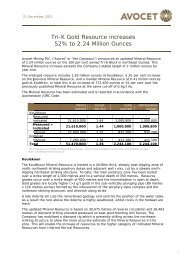Avocet Mining PLC Prospectus December 2011
Avocet Mining PLC Prospectus December 2011
Avocet Mining PLC Prospectus December 2011
Create successful ePaper yourself
Turn your PDF publications into a flip-book with our unique Google optimized e-Paper software.
c105718pu030 Proof 5: 7.12.11_13:38 B/L Revision:<br />
monetary union creating a single large trading bloc. As a consequence there is a drive to develop a<br />
common legal system among member countries.<br />
Burkina Faso introduced a new mining code in 1997 and this was modified further in 2003 with the<br />
law Order No. 031-2003/AN. Under this code the government has the ownership of all Mineral<br />
Resources. Therefore, neither individuals nor entities may prospect for minerals or carry on mining<br />
operations without a licence granted by the government pursuant to the mining code. The mining<br />
code guarantees a stable fiscal regime for the life of any mine developed. It also guarantees the<br />
stabilisation of financial and customs regulations and rates during the period of the exploitation to<br />
reflect the rates in place at the date of signing. However the title holder can benefit from any<br />
reductions of tax rates set up by a new law or regulation, provided it agrees to be subject to the new<br />
provisions in their entirety.<br />
There are no restrictions or distinctions between foreigners and citizens in the acquisition of mineral<br />
rights.<br />
The mining code identifies three different permits:<br />
1. Exploration permit – An exploration permit is granted by the Minister of Mines and is<br />
restricted to a total area of 250 square kilometres for all minerals. Permits have a duration of<br />
three years and may be renewed twice for a period of three years each, bringing the total<br />
exploration period to 9 years. The relinquishment of 25 per cent of the permit area is optional<br />
for the first renewal and mandatory for the second renewal.<br />
2. Exploitation permit – An exploitation permit is granted by the Council of Ministers based on<br />
recommendation of the Minister of Mines. This gives the permit holder the right to operate an<br />
industrial mine for exploitation purposes. The state automatically obtains a ten per cent<br />
participation in the venture. The permit is valid for a period of 20 years. It is renewable after<br />
the initial 20 years term for additional terms of five consecutive years until depletion of the<br />
deposit.<br />
3. Semi mechanised operations permit – It confers on its holder, within the limits of its perimeter,<br />
surface and depth, the exclusive right to exploit the mineral substances contained therein<br />
according to the provisions of mining regulations. The semi industrial exploitation permit is<br />
issued for five years, renewable by additional terms of three years each. The maximum area for<br />
which semi industrial exploitation permits are issued can not exceed one hundred hectares.<br />
Duties, royalties and taxes<br />
Gold production is subject to a government royalty rate based on the realised price of gold on the<br />
date of delivery. Gold realised prices lower or equal to US$1,000 per ounce are subject to a royalty<br />
rate of three per cent, a four per cent rate applies for realised prices between US$1,000 and US$1,300<br />
per ounce, and a five per cent royalty rate is levied on all shipments with a gold realised price greater<br />
than US$1,300 per ounce.<br />
Profits are subject to corporate tax at a rate of 27.5 per cent. In addition, mining companies at the<br />
exploitation phase benefit from a ten per cent reduction in the rate of tax, resulting in a rate of 17.5<br />
per cent throughout the production period. Repatriated dividends are subject to a 6.25 per cent<br />
withholding tax. This is a 50 per cent reduction from the standard rate of 12.5 per cent. <strong>Mining</strong><br />
operators at exploitation are subject to value added tax at a rate of 18 per cent.<br />
There is no distinction between duties or royalties payable by domestic and foreign parties.<br />
Environmental legislation<br />
In January 1994, Burkina Faso proclaimed its first environmental act (Loi No 1002/94/ADP du 19<br />
Janvier 1994 portant Code de l’Environnement au Burkina Faso). This act was then reviewed and<br />
reformulated as Law No 005/97 ADP on 17 March 1997. In conjunction with this environmental<br />
code the mining code, which became law on 22 October 1997 (Loi No 023/97/II/AN), refers to the<br />
health, safety and environmental controls governing the mining industry.<br />
The application for an exploitation permit must include an EIS, an enhancement and mitigation plan,<br />
and an environmental monitoring and management programme. The consent from the people<br />
concerned must be obtained to carry out mining activities within 100 metres of dwellings, wells,<br />
religious buildings, burials or sacred ground. The owner or user of a tract of land must also be<br />
compensated for resettlement or for the use of land, wood and water by the mining operator. Access<br />
roads, power lines and other infrastructures built for the purpose of mining can be used by the public<br />
62


